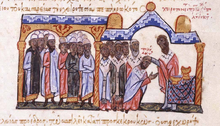Polyeuctus of Constantinople
Polyeuctus of Constantinople | |
|---|---|
| Ecumenical Patriarch of Constantinople | |
 Consecration of Polyeuctus, from the Madrid Skylitzes | |
| Installed | 956 |
| Term ended | 970 |
| Personal details | |
| Denomination | Eastern Orthodox Church |
Polyeuctus (in Greek: Πολύευκτος), (? – 5 February 970) was Ecumenical Patriarch of Constantinople (956–970).[1] His orthodox feast is on February 5.
History
Polyeuctus was raised from being a simple monk to the Patriarchate in 956, as successor to the imperial prince Theophylact Lekapenos, and remained on the patriarchal throne in Constantinople until his death on 16 January 970. For his great mind, zeal for the Faith and power of oratory, he was called a "second Chrysostom".
Although he was given his position by Constantine VII, he did not show much loyalty to him. He began by questioning the legitimacy of Constantine's parents' marriage, and then went as far as to restore the good name of Patriarch Euthymius who had so vigorously opposed that union.[2]
The Russian Princess Saint Olga came to Constantinople in the time of Patriarch Polyeuctus during the reign of Byzantine Emperor Constantine Porphyrogenitus, and was baptised there in 957. The Patriarch baptised her, and the Emperor stood godfather. St Polyeuctus prophesied: "Blessed art thou among Russian women, for thou bast desired the light and cast away darkness; the sons of Russia will bless thee to the last generation." (reference needed)
He raised bishop Petrus of Otranto (958) to the dignity of metropolitan, with the obligation to establish the Greek Rite throughout the province; the Latin Rite was introduced again after the Norman conquest, but the Greek Rite remained in use in several towns of the archdiocese and of its suffragans, until the 16th century (reference needed).
Although he had supported his rise to the throne, against the machinations of Joseph Bringas, Polyeuctus excommunicated Nikephoros II for having married Theophano on the grounds that he had been the godfather to one or more of her sons. He had previously refused Nikephoras communion for a whole year for the sin of having contracted a second marriage. Nikephoros' first wife had been dead several years when he married Theophano, but in the religious views prevalent in the Eastern Roman Empire, especially in the 10th Century, remarriage after the death of ones first wife was a sin only begrudgingly tolerated (reference needed).
Polyeuctus at least had the good grace to oppose sin on all fronts. He excommunicated the assassins of the Emperor Nikephoros II Phokas and refused to crown the new Emperor John I Tzimiskes, nephew of the late Emperor (and one of the assassins) until he punished the assassins and exiled his lover Empress Theophano who organised her husband's assassin (reference needed).
Sources and references
 This article incorporates text from a publication now in the public domain: Herbermann, Charles, ed. (1913). Catholic Encyclopedia. New York: Robert Appleton Company.
This article incorporates text from a publication now in the public domain: Herbermann, Charles, ed. (1913). Catholic Encyclopedia. New York: Robert Appleton Company. {{cite encyclopedia}}: Missing or empty|title=(help)- Neobyzantine church - liturgical calendar
